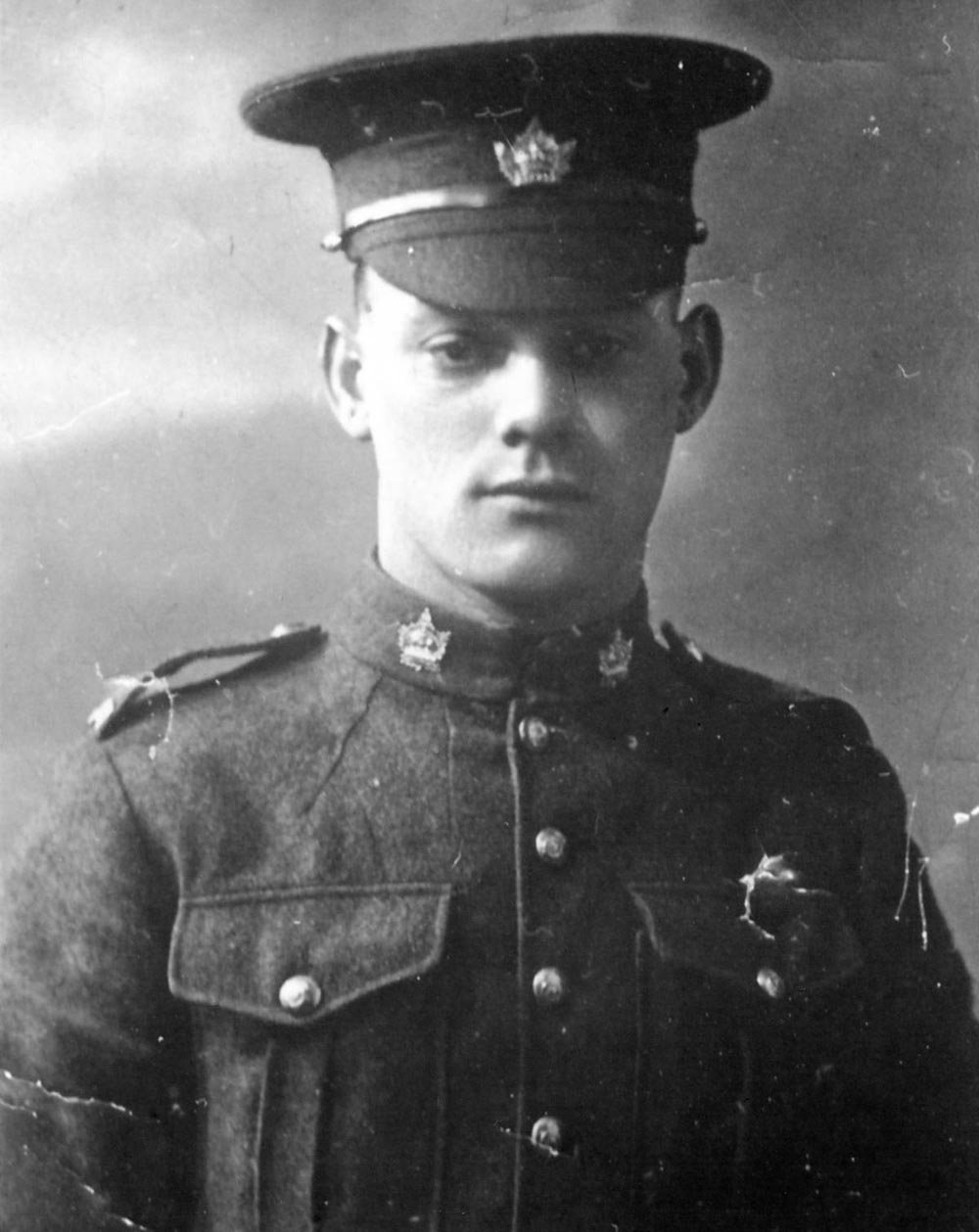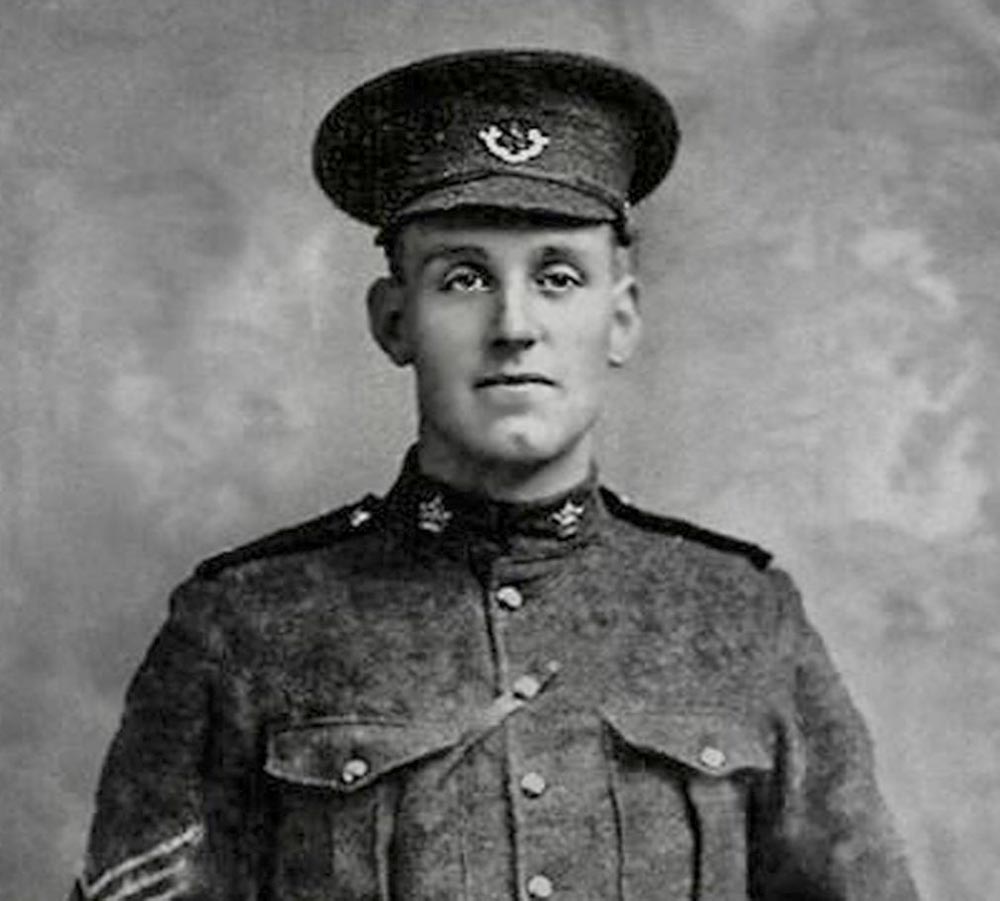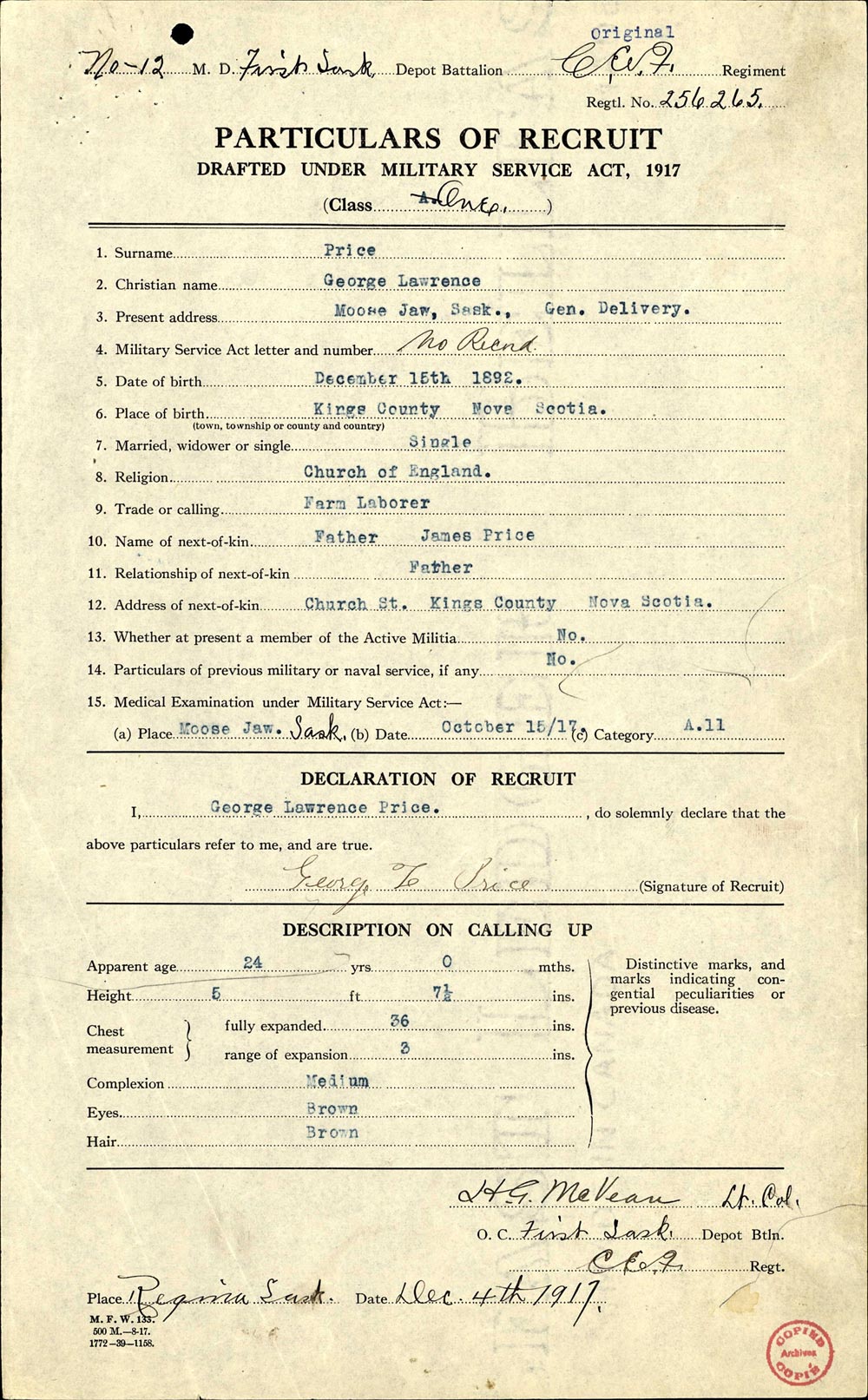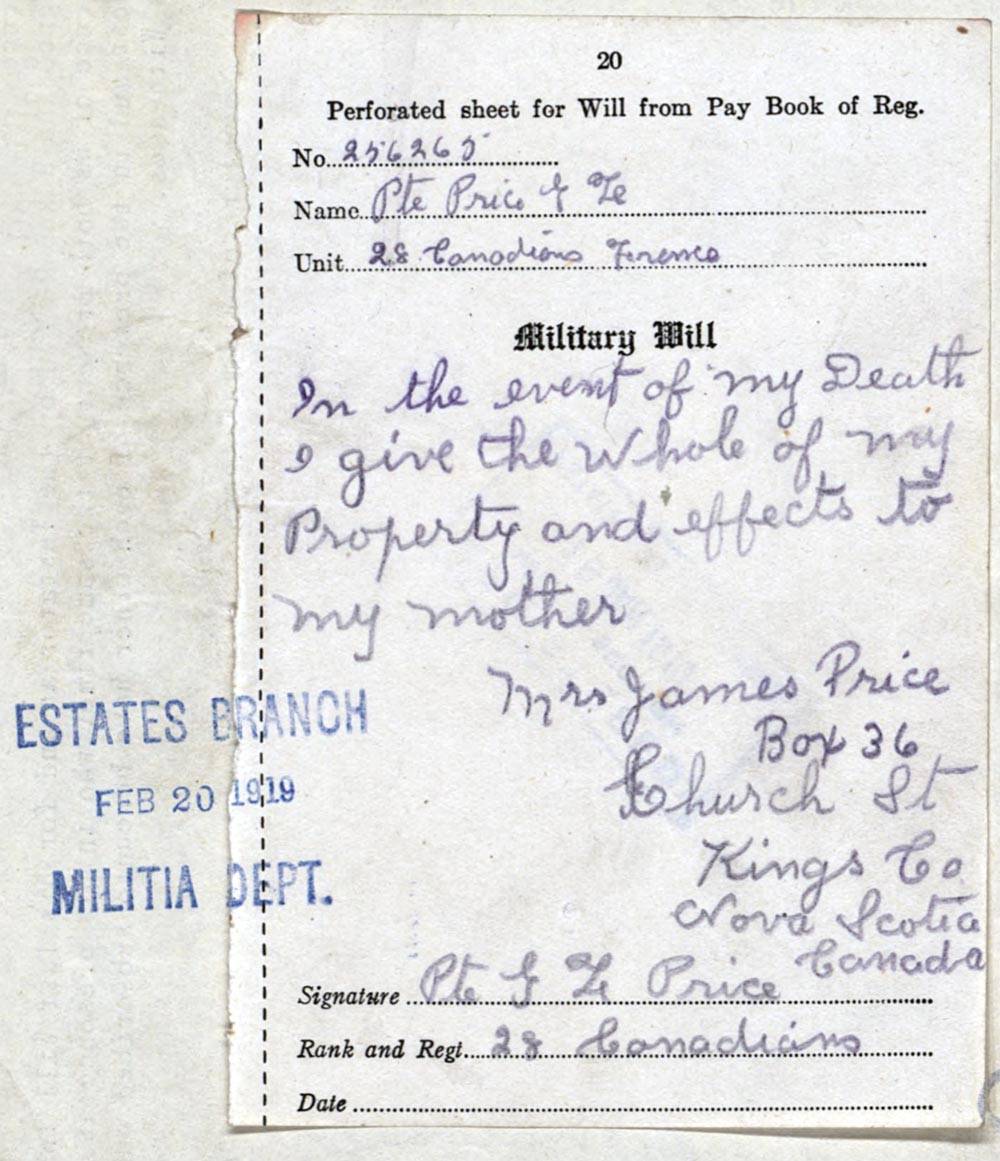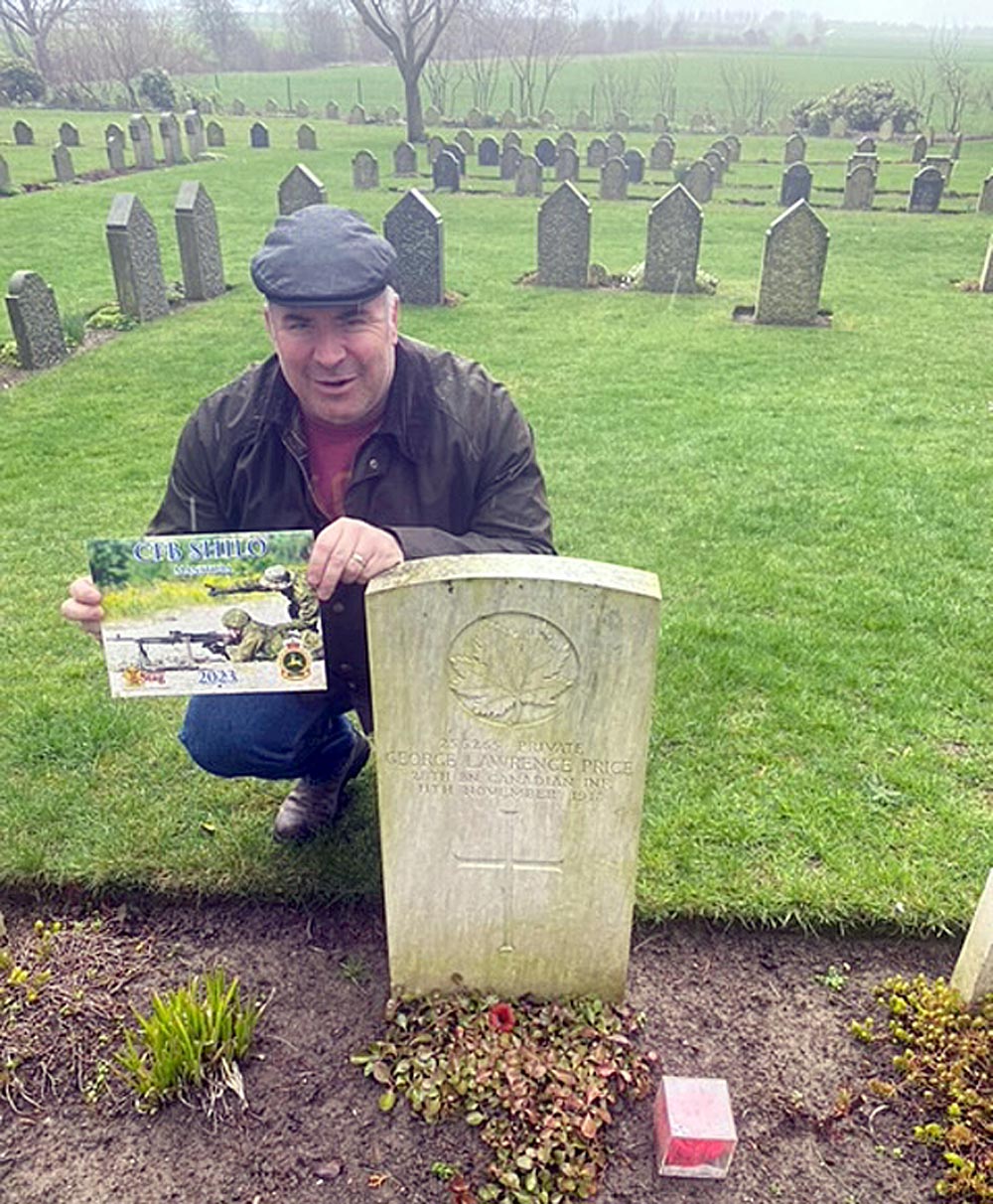
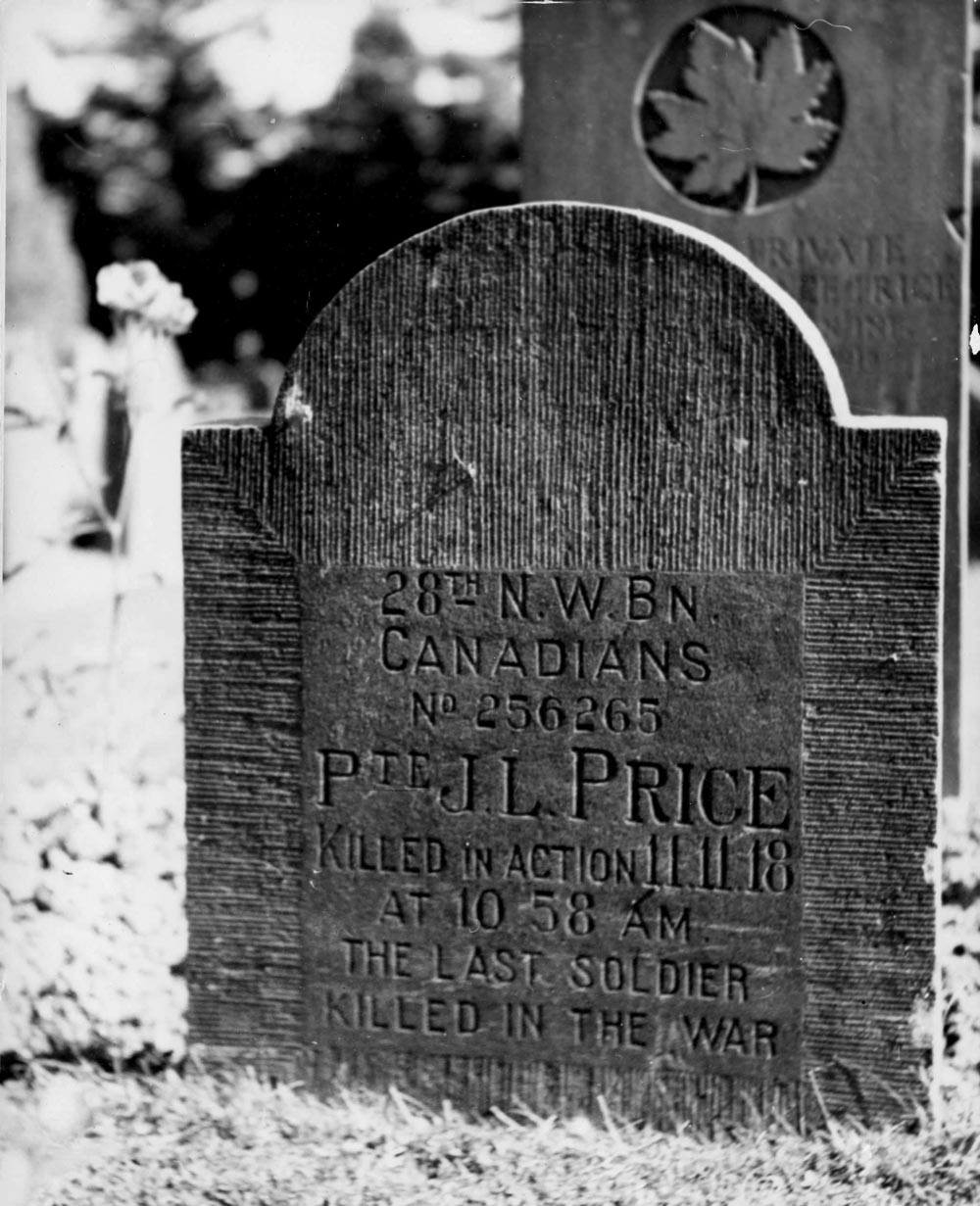
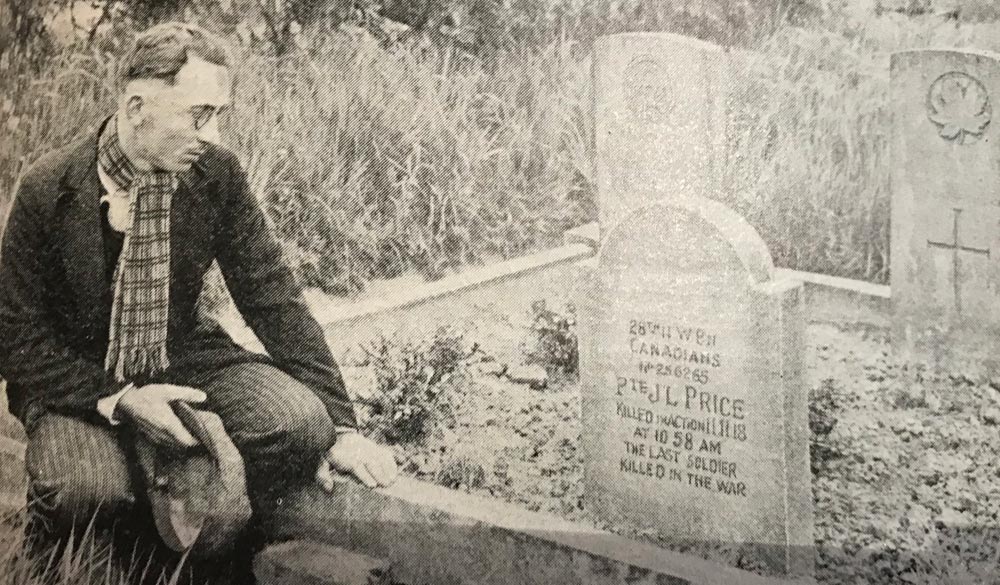
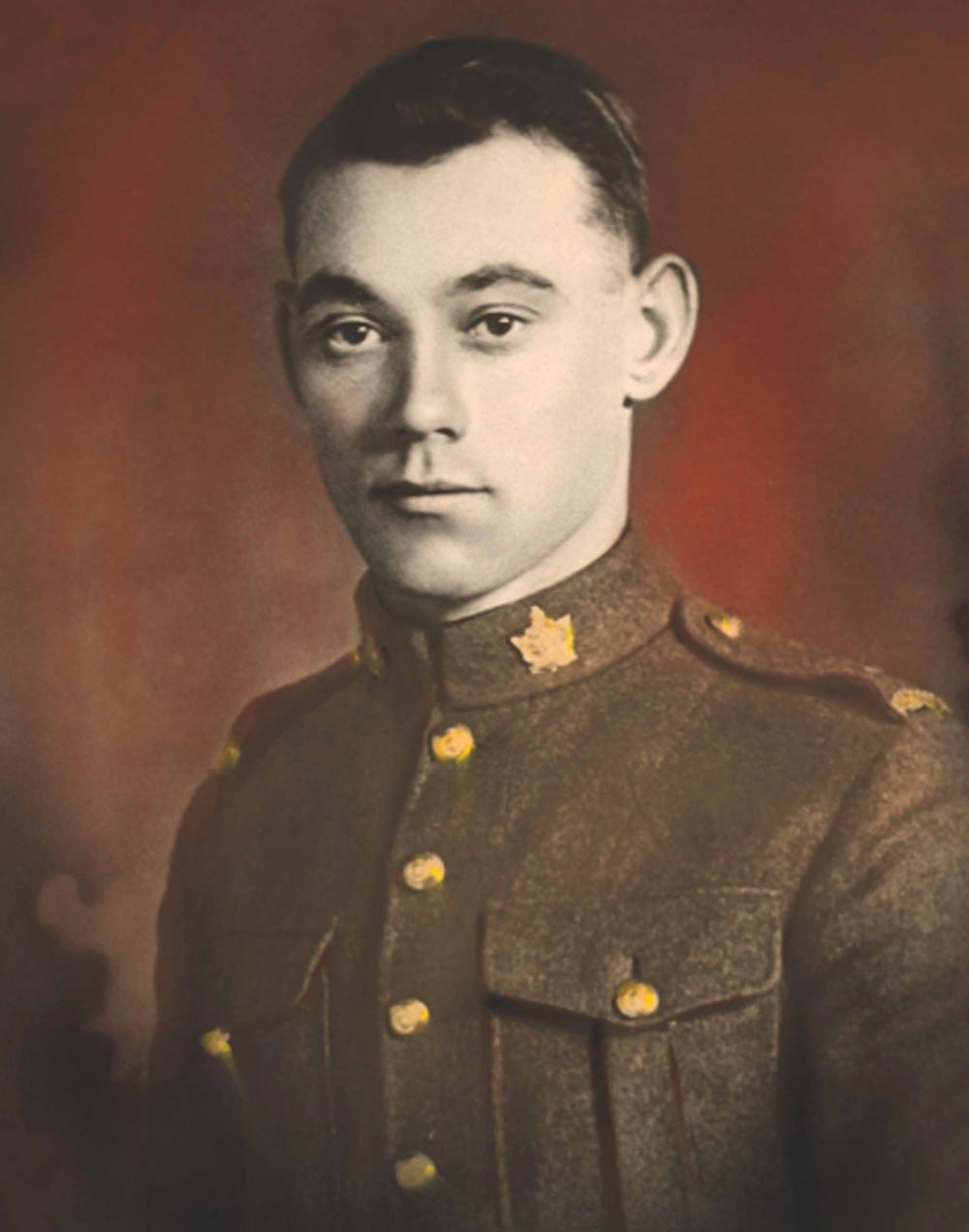
Jules Xavier
Shilo Stag
It was a sombre moment for a former 2PPCLI DCO during a visit to St. Symphorien Military Cemetery, located just southeast of Mons, Belgium.
LCol Darcy Wright, currently posted to the Supreme Headquarters Allied Powers Europe located in Casteau, Belgium, was looking for a spot overseas where he could take a photo with the CFB Shilo 2023 calendar.
While visiting the cemetery he came across the grave of Pte George Price, who was KIA by a sniper two minutes before the Armistice on Nov. 11, 1918. So, he used this historic backdrop to show the ’23 calendar which hangs in his Partnerships Directorate office, where he’s been working for more than two years after being posted from CFB Kingston, Ont.
“It is a unique military cemetery as it holds the first casualties of the First World War and the last casualties of the First World War,” said LCol Wright. “It does indeed hold both German and Commonwealth casualties, including the first Commonwealth war dead, and the last. They are buried four grave stones apart … sobering for sure.”
Born on Dec. 15, 1892, 24-year-old Pte Price is traditionally recognized as the last soldier of the British Empire to be killed during the First World War.
Born in Falmouth, Nova Scotia, and raised on Church Street, in what is now Port Williams, Nova Scotia, Pte Price was the third child of James Ephraim and Annie Rose (nee Stephens) Price. He moved to Moose Jaw, Sask., where he worked for a time with Canadian Pacific Railway.
The bachelor was conscripted in Moose Jaw on Oct. 15, 1917. The five-foot-seven, 134-pound recruit served with A Coy of the 28th Battalion (Northwest) in the Canadian Expeditionary Force (CEF). He signed his “particulars of recruit drafted under Military Service Act of 1917” paperwork — volunteers early on during the Great War signed “attestation” paperwork — in Regina on Dec. 1, 1917.
He embarked from St. John aboard SS Scotland on Jan. 21, 1918, arriving in England on on Feb. 6, where here was Taken On Strength (TOS). He joined his unit following training before leaving for France. He was wounded after the Germans shelled his position with a gas attack on Sept. 8. He was kept in hospital until Sept. 26, and rejoined his unit on Oct. 19.
On the day of his death, Nov. 11, 1918, the 2nd Division’s 6th Canadian Infantry Brigade was selected to attack this day. From the 6th Brigade, the 28th ‘North-West’ Battalion and the 31st Battalion/Alberta Regiment were chosen to lead the attack. The 28th Battalion had orders for Nov. 11 to advance from Frameries (south of Mons) and continue to the village of Havre, securing all the bridges on the Canal du Centre.
The Battalion advanced rapidly starting at 4 a.m., pushing back light German resistance and they reached their position along the canal facing Ville-sur-Haine by 9 a.m., where the battalion received a message that all hostilities would cease at 11 a.m. Pte Price and fellow soldier Art Goodmurphy were worried the Battalion’s position on the open canal bank was exposed to German positions on the opposite side of the canal where they could see bricks had been knocked out from house dormers to create firing positions.
According to Goodmurphy, the two soldiers decided on their own initiative to take a patrol of five colleagues across the bridge to search the houses. Reaching the houses and checking them one-by-one, they discovered German soldiers mounting machine guns along a brick wall overlooking the canal. The Germans opened fire on the patrol with heavy machine gun fire, but the Canadians were protected by the brick walls of one of the houses.
Aware they had been discovered and outflanked, the Germans began to retreat. A Belgian family in one of the houses warned the Canadians to be careful as they followed the retreating Germans. Pte Price was fatally shot in the chest by a German sniper as he stepped out of the house into the street.
He was pulled into one of the houses and treated by a young Belgian nurse who ran across the street to help, but he died a minute later at 10:58 a.m. His death was just two minutes before the armistice came into effect at 11 a.m.
According to the Circumstances of Casualty KIA/MIA form, Pte Price’s OC Maj A.F. Simpson wrote: “Pte Price was killed by sniper near the canal at three minutes to 11. He was shot through right breast and died shortly after being hit, although every attention possible was given him.”
Pte Price was originally buried in Havre Old Communal Cemetery, one of the cemeteries subsequently concentrated into the St Symphorien military cemetery, just southeast of Mons. Coincidentally, this is also the final resting place of Pte John Parr and Pte George Edwin Ellison, respectively the first and last British soldiers killed during the Great War.
According to Veterans Affairs Canada, Pte Price’s remains were re-interred at St Symphorien Military Cemetery after the war.
In 1968, on the 50th anniversary of his death and the armistice, surviving members of his company traveled to Ville-sur-Haine and a memorial plaque was placed onto a wall of a house near the location of his death. The inscription, in English and then in French, reads in English:
“To the memory of 256265 Private George Lawrence Price, 28th North West Battalion, 6th Canadian Infantry Brigade, 2nd Canadian Division, killed in action near this spot at 10.58 hours, November 11th, 1918, the last Canadian soldier to die on the Western Front in the First World War. Erected by his comrades, November 11th, 1968.”
The house has since been torn down, but the plaque has been placed on a brick and stone monument near the site where the house originally stood, and thus still near the place where he fell on the final day of hostilities during the Great War.
In 1991, the town of Ville-sur-Haine erected a new footbridge across the adjacent Canal du Centre. A plebiscite was held and on Nov. 11 of that year, the bridge was officially named the George Price Footbridge. On April 24, 2015, the local school in Ville-sur-Haine was renamed École George Price.
In 2016, Pte Price’s medal set and the memorial plaque were donated to the Canadian War Museum in Ottawa. On Nov. 10, 2018, then Canadian Governor General Julie Payette and other dignitaries attended the inauguration of a teardrop shaped monument in honour of Pte Price, located in Ville-sur-Haine.
Back home in Moose Jaw, Sask., on Aug. 26, 2021, a plaque was unveiled in Crescent Park commemorating “The Last Commonwealth Soldier Killed In First World War.”
Pte Price died on a Monday. It was a rainy day whose hours were almost evenly split between war and peace. And it was a terrible day to die. That Monday marked both the end of the long suffering of the First World War, and of the Canadian private’s short life. His premature death, just minutes shy of a tenuous peace, was no more or less tragic than that of countless others killed during the course of the war — or afterward, because of it.
But being the last Canadian and Commonwealth soldier to die in the war to end all wars — just as so many people were celebrating — lifted him out of almost-certain anonymity. His death on that day ultimately made him a symbol of the futility of conflict.
When Pte Price arrived overseas, and his unit arrived in France, he was part of the CEF’s Hundred Days campaign. Canadian soldiers like Pte Price were involved in a number of major battles, where they suffered heavy casualties.
While Pte Price was the last CEF soldiers KIA during the Great War, who was the first?
It turns out, the answer is a bit complicated. On Aug. 4, 1914, Britain declared war on Germany. As a dominion of the British Empire, Canada automatically entered the war with volunteers. Members of the CEF only arrived at the battlefields of France and Belgium in early 1915.
Some Canadians who were overseas when war broke out joined British forces and saw active service more quickly. British units were fighting in Belgium and France as early as August 1914, with intense combat at Mons, the Marne and Ypres, resulting in 500,000 casualties by October 1914.
Canada’s Books of Remembrance, along with the Canadian Virtual War Memorial, contain the names of more than 118,000 Canadians who fought and died in wars since Confederation. While primarily commemorating soldiers killed within Canadian units, the Books of Remembrance also commemorate those killed serving with British regiments.
They include the names of Canadians who died in service of other causes — disease, illness, accident, or injury — as well as those KIA and as the direct result of injuries received in or related to combat.
• This includes death in service, but not in combat: Pte Harry B. Little of the Princess Patricia’s Canadian Light Infantry (PPCLI) enlisted on Aug. 10, 1914, at the age of 26. He died four days later from heart failure while on a troop train in Alberta. Pte Little was buried in Alberta at Czar cemetery.
• This includes death in battle, but not for Canada: Cpl Charles Raymond served with the British infantry, 2nd Battalion, King’s Royal Rifle Corps. He was born in Windsor, Ont., and was killed in combat on Sept. 14, 1914, at age 32. He is buried in La Ferté-sous-Jouarre Memorial cemetery, Seine-et-Marne, France.
• This includes death in battle and for country: the first Canadians to die in combat while serving with a Canadian unit during the Great War were Malcolm Cann, John Hatheway, William Palmer, and Arthur Silver, on the Pacific Ocean, approximately 80 kilometres off the coast of Chile in the Battle of Coronel. They were in the first class of the newly created Royal Naval College of Canada. Under the command of British Rear Admiral Sir Christopher Cradock of the Royal Navy’s North American and West Indies station, the four men were taken as midshipmen on the HMS Good Hope, part of a squadron of ships which set out to defend British commerce from German naval aggression in the eastern Pacific. They engaged a German squadron commanded by Admiral Graf Maximilian von Spee on Nov. 1, 1914, off the coast of Chile. In what would be the worst British naval defeat in a century, more than 1,600 Allied sailors were killed in the battle, including the four Canadian midshipmen, whose ship was sunk with all hands on board.
Who was the first Commonwealth soldier to die during the Great War? Buried near Pte Price’s grave, born on July 30, 1897, Pte Parr is believed to be the first soldier of the BEF to fall in action during the First World War on Aug. 21, 1914.
After leaving school, Pte Parr took a job working as a butcher’s boy, and then as a caddie at North Middlesex Golf Club. Then, like many other young men at the time; he was attracted to the British Army as a potentially better way of life, and one where he would at least receive two meals a day and a chance to see the world.
Unlike Pte Price’s stature, Pte Parr was only five-foot-three, when he joined the 4th Battalion of the Middlesex Regiment as a professional soldier in 1912, aged 15, but claimed to be 18 years and one month old to meet the minimum age requirement.
As a teenager, Pte Parr became an infantry scout with the 4th Middlesex, whose role was to ride ahead of the battalion on the march with a detachment mounted upon bicycles to detect the enemy, or points of military note, and then return with all possible speed to notify the Battalion’s Commanding Officer (CO) as to what lay ahead.
On the outbreak of the Great War in early August 1914 the 4th Middlesex was mobilized, and was among the first British Army units of the BEF to cross the English Channel to France. With the Imperial German Army invading Belgium and France at that moment, Pte Parr’s unit took up positions near the village of Bettignies, beside the canal running through the town of Mons, approximately 13 kilometres away.
On Aug. 21, 1914, Pte Parr and another cyclist were sent to the village of Obourg, just northeast of Mons, and slightly across the border in Belgium, with orders to locate where the Germans were. It is believed whilst doing this they encountered an Uhlan patrol from the German First Army engaged in the same work, and that Pte Parr remained to hold off the enemy while his companion returned to report. He was killed in an exchange of rifle fire. The exact circumstances of his death remain unclear, and historical research in 2014 theorized he may have been killed by friendly fire rather than that from a German patrol as previously thought, or during the Battle of Mons on Aug. 23, 1914.
As the British Army retreated from the area shortly afterwards, Pte Parr’s body was left behind, and with the absence of confirmation of his fate his death was not officially recognized until much later in the conflict. His body was later found to have been buried, probably by the Germans, in a battlefield grave, which was subsequently located by the Imperial War Graves Commission. Today his grave lies in St Symphorien Military Cemetery. The age given on the gravestone is 20, the British Government at the time not knowing his true age was 17 due to his under-aged enlistment. By coincidence, his grave faces Pte George Edwin Ellison, the last British soldier thought to have been killed during the Great War, due to the close proximity in which the two men were killed.
Like in Canada with soldiers who died here during training or in England after arriving — nearby Camp Hughes has its own cemetery where soldiers there were buried after dying during training before embarking for France via Halifax — Pte Parr might have the distinction of being the first of his country to be KIA, but he was not the first such British Armed Forces casualty during the war.
On Aug. 6, 1914 the British cruiser HMS Amphion hit a German mine and sank, killing about 150 sailors of the Royal Navy. Nor was he the first British soldier to lose his life in the conflict, as several had been killed by friendly fire and accidental shootings after the declaration of war, but before troops were sent overseas, beginning with Cpl Arthur Rawson on Aug. 9, 1914.
While Pte Price’s family received his Great War medals, and Dead Man’s Penny, they also received his final pay cheque for his war service. The balance of his pay $235.39 was forwarded to mom based on his military will instructions on Aug. 9, 1919.
LCol Wright won’t soon forget his visit to Pte Price’s grave, and learning about his tragic historical moment from the Great War. Lest We Forget!
Former 2PPCLI DCO LCol Darcy Wright visited the grave of Pte George Price in a Belgium cemetery, where his showed his CFB Shilo 2023 calendar. Pte Price was KIA at two minutes to 11 a.m. on Nov. 11, 1918, becoming the last CEF soldier to die in the bloodshed of the Great War. From Moose Jaw, Sask., Pte Price is buried near the last BEF soldier to be killed on the last day of fighting in France and Belgium, when German high command signed the surrender papers. Attached here is his conscription paperwork, plus the will he wrote leaving all of his possessions and pay to his mother in Nova Scotia if he was to be killed overseas. A few of his Great War portraits taken when before he sailed overseas.
Pte George Price’s original grave following his death on Nov. 11, 1918, with marker, was located at Havre Old Communal Cemetery in Belgium. He was then moved to St Symphorien Cemetery in 1948. The photo above with a man holding a hat appeared in the 1938 publication The Great War — I Was There. With the 28 Canadians, he was KIA by a sniper at 10:58 a.m. on 11/11/18, Armistice Day. He was the last CEF and Commonwealth soldier to die in the First World War. The man at his grave paying respects is unknown, but may have been a fellow soldier or a family member.
